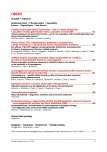Cytomegalovirus – specific cellular imunity: profile of immune function assesment provides clinically relevant answer
Authors:
L. Król 1,2; D. Kotus 1; D. Thürner 1; P. Hubáček 2; P. Sedláček 2; O. Hrušák 1,2; J. Starý 2; T. Kalina 1,2
Authors‘ workplace:
CLIP – Cytometrie, Klinika dětské hematologie a onkologie, UK 2. lékařská fakulta a FN Motol
1; Klinika dětské hematologie a onkologie, UK 2. lékařská fakulta a FN Motol
2
Published in:
Transfuze Hematol. dnes,16, 2010, No. 3, p. 141-149.
Category:
Comprehensive Reports, Original Papers, Case Reports
Overview
Introduction:
Effective immune response, mediated by T-cells in particular, is necessary to control CMV infection. Children after hematopoietic stem cell transplantation (HSCT) are highly vulnerable to repeated, often life-threatening CMV infections, due to secondary immunodeficiency caused by conditioning regimens.
Methods:
We examined peripheral blood mononuclear cells of 57 healthy volunteers and 10 patients two or more years after HSCT for CMV antigen evoked ex vivo T-cell responses. We compared responses between CMV positive and CMV negative donors. We also compared responses among the CMV-positive children, adults and patients recovered two or more years after HSCT. Measurement of intracellular cytokines (IFN-γ and IL-2), activation molecule CD154 (CD40L), a marker of degranulation (CD107a) allowed us to define different subsets of CD4+ and CD8 + T-cell responses using multicolor flow cytometry.
Results:
We found following subsets relevant for CMV control by comparing CMV seropositive and seronegative volunteers among CD4+ T-cells: IFN-γ+/CD40L+ and IFN-γ+/IL-2+/CD40L+. There were also five relevant populations among CD8+ T-cells: IFN-γ+/ IL-2+/CD107a+/CD40L+, IFN-γ+/IL-2+/CD40L+, IFN-γ+/IL2+, IFN-γ+/CD40L+ and IFN-γ+. When comparing children’s and adult healthy donors to patients 2 or more years after HSCT with fully restored immunity, we found no statistically significant differences, thus CMV specific immunity is fully restored after HSCT. Finally, we demonstrate comparison of the immune function profile of patients at risk of reactivation with those with fully restored immunity.
Conclusion:
In conclusion, ex vivo testing of CMV specific T-cell immune responses is a valuable tool for immune monitoring of patients after HSCT and complements the already established method of CMV viral load monitoring using quantitative PCR.
Key words:
cytomegalovirus, hematopoietic stem cell transplantation, intracellular detection of cytokines, flow-cytometry, immune reconstitution
Sources
1. Scholz M, Doerr HW, Cinatl J. Human cytomegalovirus retinitis: pathogenicity, immune evasion and persistence. Trends Microbiol 2003; 11:171-178.
2. Storek J, Geddes M, Khan F, et al. Reconstitution of the immune system after hematopoietic stem cell transplantation in humans. Semin Immunopathol 2008; 30: 425-437.
3. Boeckh M, Ljungman P. How we treat cytomegalovirus in hematopoietic cell transplant recipients. Blood 2009; 113: 5711-5719.
4. Baldanti F, Lilleri D, Gerna G. Monitoring human cytomegalovirus infection in transplant recipients. J Clin Virol 2008; 41: 237-241.
5. Zhou W, Longmate J, Lacey SF, et al. Impact of donor CMV status on viral infection and reconstitution of multifunction CMV-specific T cells in CMV-positive transplant recipients. Blood 2009; 113: 6465-6476.
6. Ljungman P, Perez-Bercoff L, Jonsson J, et al. Risk factors for the development of cytomegalovirus disease after allogeneic stem cell transplantation. Haematologica 2006; 91: 78-83.
7. Hakki M, Riddell SR, Storek J, et al. Immune reconstitution to cytomegalovirus after allogeneic hematopoietic stem cell transplantation: impact of host factors, drug therapy, and subclinical reactivation. Blood 2003; 102: 3060-3067.
8. Singh N. Antiviral drugs for cytomegalovirus in transplant recipients: advantages of preemptive therapy. Rev Med Virol 2006; 16: 281-287.
9. Verkruyse LA, Storch GA, Devine SM, Dipersio JF, Vij R. Once daily ganciclovir as initial pre-emptive therapy delayed until threshold CMV load > or =10000 copies/ml: a safe and effective strategy for allogeneic stem cell transplant patients. Bone Marrow Transplant 2006; 37: 51-56.
10. Pourgheysari B, Piper KP, McLarnon A, et al. Early reconstitution of effector memory CD4+ CMV-specific T cells protects against CMV reactivation following allogeneic SCT. Bone Marrow Transplant 2009; 43: 853-861.
11. Eid AJ, Brown RA, Hogan WJ, et al. Kinetics of interferon-gamma producing cytomegalovirus (CMV)-specific CD4+ and CD8+ T lymphocytes and the risk of subsequent CMV viremia after allogeneic hematopoietic stem cell transplantation. Transplant Infect Dis 2009; 11: 519-528.
12. Barron MA, Gao D, Springer KL, et al. Relationship of reconstituted adaptive and innate cytomegalovirus (CMV)-specific immune responses with CMV viremia in hematopoietic stem cell transplant recipients. Clin Infect Dis 2009; 49: 1777-1783.
13. Gratama JW, Brooimans RA, van der Holt B, et al. Monitoring cytomegalovirus IE-1 and pp65-specific CD4+ and CD8+ T-cell responses after allogeneic stem cell transplantation may identify patients at risk for recurrent CMV reactivations. Cytometry B Clin Cytom 2008; 74: 211-220.
14. Morita-Hoshi Y, Heike Y, Kawakami M, et al. Functional analysis of cytomegalovirus-specific T lymphocytes compared to tetramer assay in patients undergoing hematopoietic stem cell transplantation. Bone Marrow Transplant 2008; 41: 515-521.
15. Tanaka N, Kimura H, Iida K, et al. Quantitative analysis of cytomegalovirus load using a real-time PCR assay. J Med Virol 2000; 60: 455-462.
16. Betts MR, Nason MC, West SM, et al. HIV nonprogressors preferentially maintain highly functional HIV-specific CD8+ T cells. Blood 2006; 107: 4781-4789.
17. Zimmerli SC, Harari A, Cellerai C, et al. HIV-1-specific IFN-gamma/IL-2-secreting CD8 T cells support CD4-independent proliferation of HIV-1-specific CD8 T cells. Proc Natl Acad Sci U S A 2005; 102: 7239-7244.
Labels
Haematology Internal medicine Clinical oncologyArticle was published in
Transfusion and Haematology Today

2010 Issue 3
- Administration of aPCC as a Prevention of Bleeding After Major Cardiac Surgical Procedures
- The Importance of Hydration in Wound Healing
- Cost Effectiveness of FVIII Substitution Versus Non-Factor Therapy for Hemophilia A
- Vascular Disease in the Gradually Aging Population of Hemophiliacs: An Underestimated Problem?
- Prognostic Significance of Subclinical Joint Changes on MRI in Hemophilia
Most read in this issue
- Hairy cell leukemia – diagnostics, treatment and monoclonal antibodies
- Follicullar lymphoma and the significance of its tumour microenvironment
- Cytomegalovirus – specific cellular imunity: profile of immune function assesment provides clinically relevant answer
- Immunophenotypic characterization of acute leukemias of ambiguous lineage- new diagnostic entity of the revised WHO classification 2008
